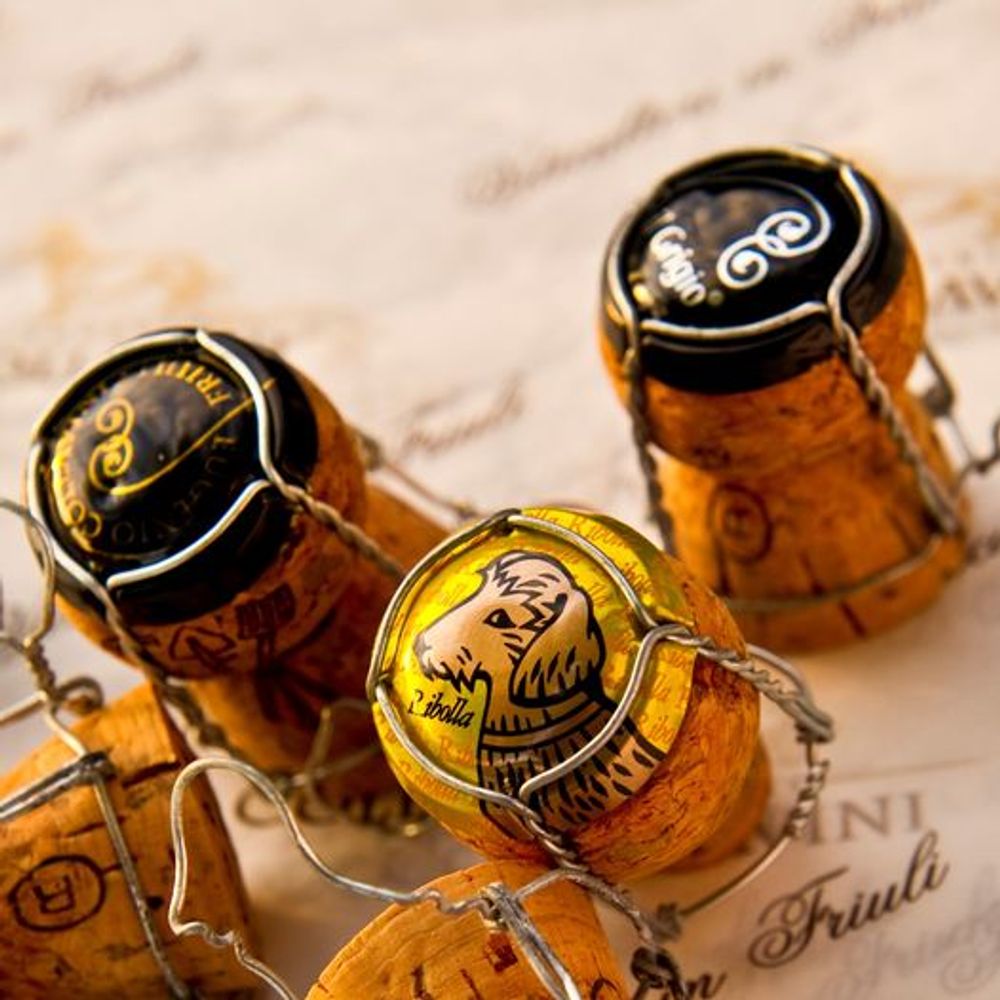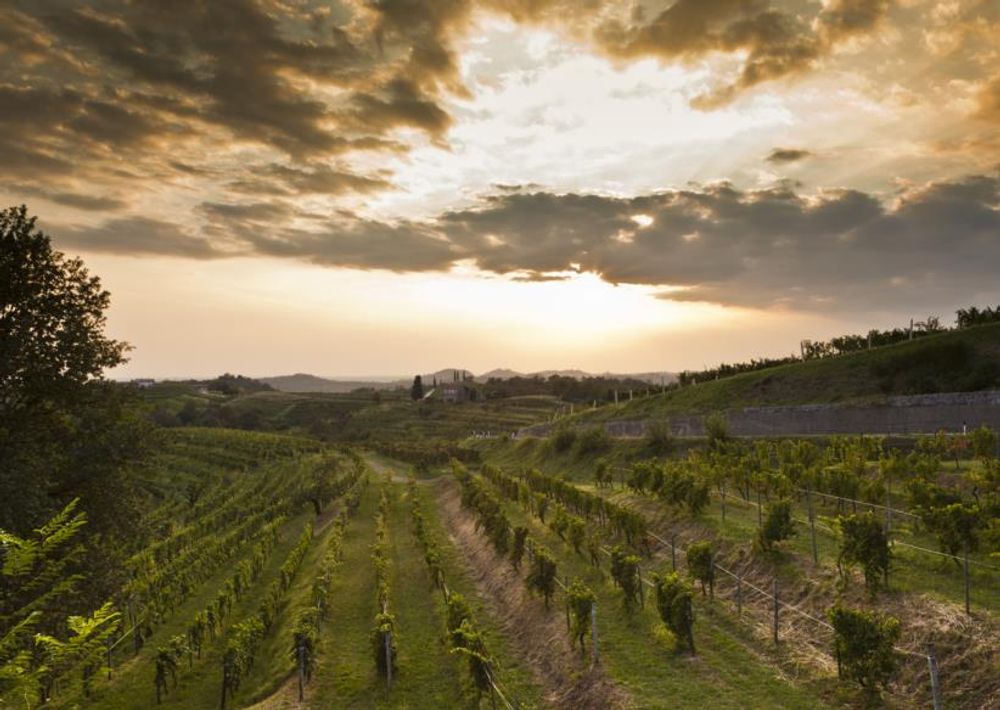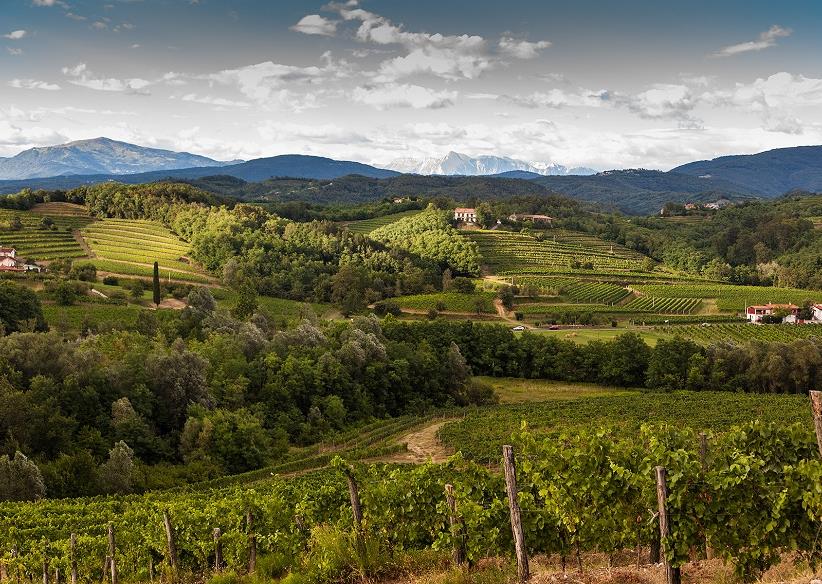“We are constantly attentive to the market, but want to keep to our roots and traditions, that are based in the vineyard,” Collavini says.
It is not common practice, in my experience, for producers to include a fully bound 180 page, illustrated hardback book along with the wines they send for a Zoom tasting.
But then Collavini is hardly an ordinary producer.

Luigi Collavini ha ritirato il premio assegnato al padre Manlio
The book “The Lord of Ribolla Gialla” is devoted to Manlio Collavini, one of the most respected producers on Italy’s wine scene and best known for reviving Friuli’s renowned autochthonous grape variety Ribolla Gialla, grown in the Collio region next to – and beyond – the border with Slovenia. But he is famous for rather more than this: lovers of Pinot Grigio have him to thank for this variety now being vinified as a white wine rather than off pink as was common until the 1980s. Manlio Collavini produced his first white Pinot Grigio back in 1966, setting the scene for this once under- appreciated variety to become the massively popular behemoth that it is today.
Collavini has come a long way since Manlio’s grandfather Eugenio established the winery in far eastern Italy on the Slovenian border – in then Austria-Hungary – 124 years ago. Located in Gramogliano di Corno di Rosazzo, straddling the two key Friulian DOCs of Colli Orientale and Collio, Collavini produces 1.5 million bottles which it exports to some 50 countries. Collavini remains focused largely on local indigenous varieties like Ribolla Gialla, Pignolo, Schiopettino and Fruliano (formerly known as Tocai until Italian producers were officially banned from using this name following a brand dispute with Hungary), although international varieties are also produced, particularly for some of the sparkling wines but also red (Merlot).
Volume may have risen but the commitment to quality remains – yields in this region of Friuli-Venezia are amongst the lowest in Italy, and Collavini pays great attention to appearances; each of the bottles are lovingly packaged in branded paper whilst an image of Ribolla – Manlio Collavini’s cute but now sadly departed Dachshund- decorates the front of each bottle.

A quality outfit then, but how are the wines?
Luigi Collavini – one of Manlio’s sons – took us through them, starting with the sparkling Ribolla Gialla 2017, a unique local variety made in a unique way, Metodo Collavini Millesimato.
“We had several attempts at making Ribolla Gialla into a sparkling wine, including methode champenoise and charmat but none really gave the right results. Metodo Collavini is a combination of the two approaches, with the wine first going into barrel-ageing before going into horizontal stainless steel tanks for 32 months. After bottling the wine is laid down for several months before release.”
Collavini reckons this unique approach results in a very elegant wine and it is hard to argue; wonderfully fresh and lively, this is very moreish and carries its 6.5 grams dosage very well. Definitely one to try.
The next two wines – Ribolla Gialla 2019 and Schioppettino 2015 – both come from the oldest vineyard on the estate, the Clos Turian, and are very low yielding. One look at the Ribolla Gialla suggests this wine is well-named – it is almost bright yellow. Made without skin contact, there is weight here reflecting the grapes being left on trays to partially dry before crushing. This is a rounded, complex wine with lots of flavour on the palate, white fennel and saffron, with a spicy finish and well-balanced acidity.
The Schioppettino is made the same way to produce a medium weight wine – Luigi Collavini suggests it’s a perfect lunchtime red – but as befits this variety (aka Ribolla Nera) this is lively, spicy with some good fruit intensity.
The T-Fruliano 2020 (T recalls Tocai, the name this grape is still widely known as) from the Collio DOC is very different. Collavini says this is the local grape “closest to our hearts” and it offers a wide taste spectrum, fresh pears and peaches but a nutty finish. Moreish.
HN Wines has been importing Collavini wines for several years and say customers love them for their sheer authenticity.
“Collavini is one of the original, pioneering wine producers in Friuli-Venezia Giulia. Founded in 1896 – and remaining in the same family for generations – they have been first in the area to introduce many different styles and techniques to the region, including creating the first sparkling Ribolla Gialla and partially drying grapes in order to concentrate the flavours,” says head buyer Steve Daniel.
This technique is used in Collavini’s multi award-winning Friulano, Chardonnay, Sauvignon Blanc blend, Broy, which features within the Tre Bicchieri line-up every year. For Luigi Collavini, concentrating the grape juice in trays before making the wine gives complexity and depth.

“We first started making Broy in 2003 because we wanted to use most of the legally permissible white grapes in a wine that would show the complexity of the region. Each grape brings something different to the mix – Chardonnay, the elegance reflecting the character of what I believe is the best white grape variety in the world; Sauvignon Blanc for its aromas and freshness and Fruliano to give the typicity. Though I say so myself this is an amazing blend,” he says.
The other really distinctive wine – though one that is not currently imported by HN Wines – is Pignolo, which Collavini has been producing in tiny quantities since 2009, and which is currently on the 2012 vintage. Not a variety I was familiar with, this Friulian grape is famous for its dark colour and mature tannins and here it comes across as a heftily complex wine, lots of red and dark bramble fruit, and morello cherries, all supported by firm acidity and a weighty body. Collavini recommends opening some three to four hours before drinking and allowing it lots of air.
“This is quite an international style but at the same time, very textured and intense. But hard to place or compare. I read one review that even mentioned church pews and incense but I’ll leave the descriptions to others.”
Fair enough, but one thing is sure – more time will give this big wine still greater complexity and depth.
Quite different is Collavini’s Pucino Refosco 2020, made from the variety beloved of Friulians and Slovenes alike. Here the wine is of medium weight (and a reassuring 12.5%) but very spicy and quite complex. This is another fascinating and ancient variety – known to the ancient Romans – and here is shown in a gloriously unvarnished style, the grapes de-stemmed and macerated before going into stainless steel. This would work with fish and other light dishes.
The other two whites, both stocked by HN Wines, offer a good and solid introduction to the range; the Pinot Grigio Collio Canlungo 2020 and the Ribolla Gialla IGT 2020 are both well worth trying, and are well-priced, at under £15 trade, but showing the hallmarks of high quality that define the rest of the Collavini range.
So what does the future hold for this leading Friulian producer? Luigi Collavini says he is keen to boost exports but has other – maybe higher – priorities as well.
“We are constantly attentive to the market, but want to keep to our roots and traditions, that are based in the vineyard,” he says.
“Considering how very close we are to Slovenia – the hills surrounding our winery are the same as over there – we hope to use wine to eliminate borders. Going forward, our propensity will be to make wines on vineyards that actually do cross borders.”




































